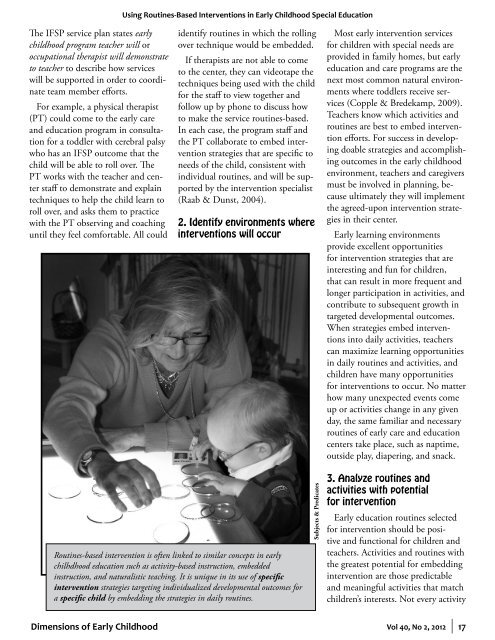Water Play - Southern Early Childhood Association
Water Play - Southern Early Childhood Association
Water Play - Southern Early Childhood Association
Create successful ePaper yourself
Turn your PDF publications into a flip-book with our unique Google optimized e-Paper software.
Using Routines-Based Interventions in <strong>Early</strong> <strong>Childhood</strong> Special Education<br />
The IFSP service plan states early<br />
childhood program teacher will or<br />
occupational therapist will demonstrate<br />
to teacher to describe how services<br />
will be supported in order to coordinate<br />
team member efforts.<br />
For example, a physical therapist<br />
(PT) could come to the early care<br />
and education program in consultation<br />
for a toddler with cerebral palsy<br />
who has an IFSP outcome that the<br />
child will be able to roll over. The<br />
PT works with the teacher and center<br />
staff to demonstrate and explain<br />
techniques to help the child learn to<br />
roll over, and asks them to practice<br />
with the PT observing and coaching<br />
until they feel comfortable. All could<br />
identify routines in which the rolling<br />
over technique would be embedded.<br />
If therapists are not able to come<br />
to the center, they can videotape the<br />
techniques being used with the child<br />
for the staff to view together and<br />
follow up by phone to discuss how<br />
to make the service routines-based.<br />
In each case, the program staff and<br />
the PT collaborate to embed intervention<br />
strategies that are specific to<br />
needs of the child, consistent with<br />
individual routines, and will be supported<br />
by the intervention specialist<br />
(Raab & Dunst, 2004).<br />
2. Identify environments where<br />
interventions will occur<br />
Most early intervention services<br />
for children with special needs are<br />
provided in family homes, but early<br />
education and care programs are the<br />
next most common natural environments<br />
where toddlers receive services<br />
(Copple & Bredekamp, 2009).<br />
Teachers know which activities and<br />
routines are best to embed intervention<br />
efforts. For success in developing<br />
doable strategies and accomplishing<br />
outcomes in the early childhood<br />
environment, teachers and caregivers<br />
must be involved in planning, because<br />
ultimately they will implement<br />
the agreed-upon intervention strategies<br />
in their center.<br />
<strong>Early</strong> learning environments<br />
provide excellent opportunities<br />
for intervention strategies that are<br />
interesting and fun for children,<br />
that can result in more frequent and<br />
longer participation in activities, and<br />
contribute to subsequent growth in<br />
targeted developmental outcomes.<br />
When strategies embed interventions<br />
into daily activities, teachers<br />
can maximize learning opportunities<br />
in daily routines and activities, and<br />
children have many opportunities<br />
for interventions to occur. No matter<br />
how many unexpected events come<br />
up or activities change in any given<br />
day, the same familiar and necessary<br />
routines of early care and education<br />
centers take place, such as naptime,<br />
outside play, diapering, and snack.<br />
Routines-based intervention is often linked to similar concepts in early<br />
chilhdhood education such as activity-based instruction, embedded<br />
instruction, and naturalistic teaching. It is unique in its use of specific<br />
intervention strategies targeting individualized developmental outcomes for<br />
a specific child by embedding the strategies in daily routines.<br />
Subjects & Predicates<br />
3. Analyze routines and<br />
activities with potential<br />
for intervention<br />
<strong>Early</strong> education routines selected<br />
for intervention should be positive<br />
and functional for children and<br />
teachers. Activities and routines with<br />
the greatest potential for embedding<br />
intervention are those predictable<br />
and meaningful activities that match<br />
children’s interests. Not every activity<br />
Dimensions of <strong>Early</strong> <strong>Childhood</strong> Vol 40, No 2, 2012 17
















